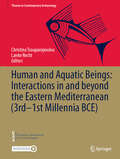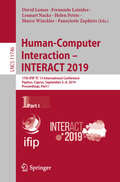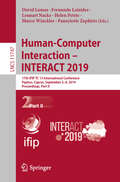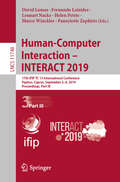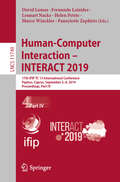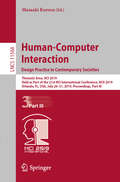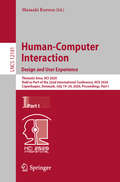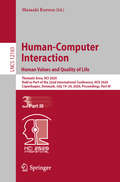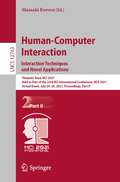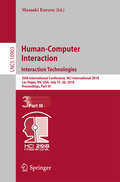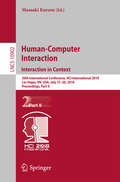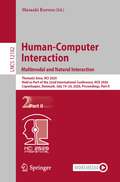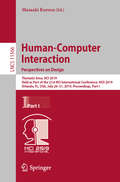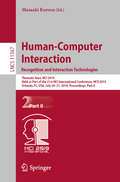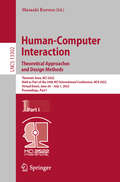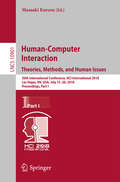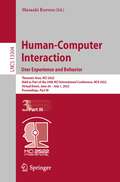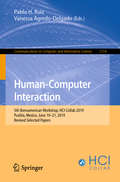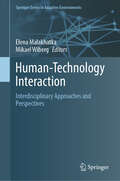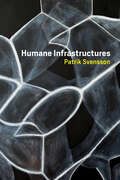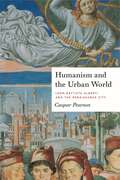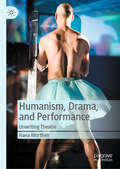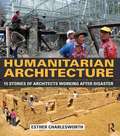- Table View
- List View
Human and Aquatic Beings: Interactions in and beyond the Eastern Mediterranean (Themes in Contemporary Archaeology)
by Lærke Recht Christina TsouparopoulouThis volume examines the role of fish and molluscs in everyday life as well as in terms of their impact on social structures, and as part of ideological and symbolic expression. Given the prevalence of anddependence on water in various forms in all regions of the Eastern Mediterranean, Egypt and Western Asia, it is no wonder that fish and other aquatic species made an impact on human lives. Yet this topic remains rather understudied. Until recently, ongoing projects in marine and freshwater species and their interaction with humans and the environment either focus on the European marine ecosystem or on themes other than the social interactions of humans and aquatic species. The chapters in this volume explore questions related to fishing practices and technologies, social status, human-fish/mollusc relations (including potential over-exploitation), and fish/molluscs in ritual practices (e.g. as temple offerings, festival consumption, burial offerings), and ideology and religion (e.g. associated with supernatural beings or sacred space, as hybrid creatures, and as represented in luxury goods). The volume also examines aquatic species as a nonalimentary resource, for example as jewellery, inlays, dyeing and medicinal purposes. The material under investigation includes faunal remains (worked and unworked), fishing gear and related tools, iconography and written sources. Many chapters also integrate multiple lines of evidence, ranging from stylistic, contextual and iconographic analyses to zooarchaeological investigations. This volume is relevant to archaeologists, zooarchaeologists, biologists and anyone interested in human-animal relations and/or the archaeology of the early Eastern Mediterranean and surrounding regions.
Human-Centered Built Environment Heritage Preservation: Theory and Evidence-Based Practice
by Barry L. Stiefel Jeremy C. WellsHuman-Centered Built Environment Heritage Preservation addresses the question of how a human-centred conservation approach can and should change practice. For the most part, there are few answers to this question because professionals in the heritage conservation field do not use social science research methodologies to manage cultural landscapes, assess historical significance and inform the treatment of building and landscape fabric. With few exceptions, only academic theorists have explored these topics while failing to offer specific, usable guidance on how the social sciences can actually be used by heritage professionals. In exploring the nature of a human-centred heritage conservation practice, we explicitly seek a middle ground between the academy and practice, theory and application, fabric and meanings, conventional and civil experts, and orthodox and heterodox ideas behind practice and research. We do this by positioning this book in a transdisciplinary space between these dichotomies as a way to give voice (and respect) to multiple perspectives without losing sight of our goal that heritage conservation practice should, fundamentally, benefit all people. We believe that this approach is essential for creating an emancipated built heritage conservation practice that must successfully engage very different ontological and epistemological perspectives.
Human-Computer Interaction – INTERACT 2019: 17th IFIP TC 13 International Conference, Paphos, Cyprus, September 2–6, 2019, Proceedings, Part I (Lecture Notes in Computer Science #11746)
by David Lamas Marco Winckler Panayiotis Zaphiris Helen Petrie Fernando Loizides Lennart NackeThe four-volume set LNCS 11746–11749 constitutes the proceedings of the 17th IFIP TC 13 International Conference on Human-Computer Interaction, INTERACT 2019, held in Paphos, Cyprus, in September 2019. The total of 111 full papers presented together with 55 short papers and 48 other papers in these books was carefully reviewed and selected from 385 submissions. The contributions are organized in topical sections named: Part I: accessibility design principles; assistive technology for cognition and neurodevelopment disorders; assistive technology for mobility and rehabilitation; assistive technology for visually impaired; co-design and design methods; crowdsourcing and collaborative work; cyber security and e-voting systems; design methods; design principles for safety/critical systems. Part II: e-commerce; education and HCI curriculum I; education and HCI curriculum II; eye-gaze interaction; games and gamification; human-robot interaction and 3D interaction; information visualization; information visualization and augmented reality; interaction design for culture and development I. Part III: interaction design for culture and development II; interaction design for culture and development III; interaction in public spaces; interaction techniques for writing and drawing; methods for user studies; mobile HCI; personalization and recommender systems; pointing, touch, gesture and speech-based interaction techniques; social networks and social media interaction. Part IV: user modelling and user studies; user experience; users’ emotions, feelings and perception; virtual and augmented reality I; virtual and augmented reality II; wearable and tangible interaction; courses; demonstrations and installations; industry case studies; interactive posters; panels; workshops.The chapter ‘Analyzing Accessibility Barriers Using Cost-Benefit Analysis to Design Reliable Navigation Services for Wheelchair Users’ is open access under a CC BY 4.0 license.
Human-Computer Interaction – INTERACT 2019: 17th IFIP TC 13 International Conference, Paphos, Cyprus, September 2–6, 2019, Proceedings, Part II (Lecture Notes in Computer Science #11747)
by David Lamas Marco Winckler Panayiotis Zaphiris Helen Petrie Fernando Loizides Lennart NackeThe four-volume set LNCS 11746–11749 constitutes the proceedings of the 17th IFIP TC 13 International Conference on Human-Computer Interaction, INTERACT 2019, held in Paphos, Cyprus, in September 2019.The total of 111 full papers presented together with 55 short papers and 48 other papers in these books was carefully reviewed and selected from 385 submissions. The contributions are organized in topical sections named:Part I: accessibility design principles; assistive technology for cognition and neurodevelopment disorders; assistive technology for mobility and rehabilitation; assistive technology for visually impaired; co-design and design methods; crowdsourcing and collaborative work; cyber security and e-voting systems; design methods; design principles for safety/critical systems. Part II: e-commerce; education and HCI curriculum I; education and HCI curriculum II; eye-gaze interaction; games and gamification; human-robot interaction and 3D interaction; information visualization; information visualization and augmented reality; interaction design for culture and development I. Part III: interaction design for culture and development II; interaction design for culture and development III; interaction in public spaces; interaction techniques for writing and drawing; methods for user studies; mobile HCI; personalization and recommender systems; pointing, touch, gesture and speech-based interaction techniques; social networks and social media interaction. Part IV: user modelling and user studies; user experience; users’ emotions, feelings and perception; virtual and augmented reality I; virtual and augmented reality II; wearable and tangible interaction; courses; demonstrations and installations; industry case studies; interactive posters; panels; workshops.
Human-Computer Interaction – INTERACT 2019: 17th IFIP TC 13 International Conference, Paphos, Cyprus, September 2–6, 2019, Proceedings, Part III (Lecture Notes in Computer Science #11748)
by David Lamas Marco Winckler Panayiotis Zaphiris Helen Petrie Fernando Loizides Lennart NackeThe four-volume set LNCS 11746–11749 constitutes the proceedings of the 17th IFIP TC 13 International Conference on Human-Computer Interaction, INTERACT 2019, held in Paphos, Cyprus, in September 2019.The total of 111 full papers presented together with 55 short papers and 48 other papers in these books was carefully reviewed and selected from 385 submissions. The contributions are organized in topical sections named:Part I: accessibility design principles; assistive technology for cognition and neurodevelopment disorders; assistive technology for mobility and rehabilitation; assistive technology for visually impaired; co-design and design methods; crowdsourcing and collaborative work; cyber security and e-voting systems; design methods; design principles for safety/critical systems. Part II: e-commerce; education and HCI curriculum I; education and HCI curriculum II; eye-gaze interaction; games and gamification; human-robot interaction and 3D interaction; information visualization; information visualization and augmented reality; interaction design for culture and development I. Part III: interaction design for culture and development II; interaction design for culture and development III; interaction in public spaces; interaction techniques for writing and drawing; methods for user studies; mobile HCI; personalization and recommender systems; pointing, touch, gesture and speech-based interaction techniques; social networks and social media interaction. Part IV: user modelling and user studies; user experience; users’ emotions, feelings and perception; virtual and augmented reality I; virtual and augmented reality II; wearable and tangible interaction; courses; demonstrations and installations; industry case studies; interactive posters; panels; workshops.
Human-Computer Interaction – INTERACT 2019: 17th IFIP TC 13 International Conference, Paphos, Cyprus, September 2–6, 2019, Proceedings, Part IV (Lecture Notes in Computer Science #11749)
by David Lamas Marco Winckler Panayiotis Zaphiris Helen Petrie Fernando Loizides Lennart NackeThe four-volume set LNCS 11746–11749 constitutes the proceedings of the 17th IFIP TC 13 International Conference on Human-Computer Interaction, INTERACT 2019, held in Paphos, Cyprus, in September 2019.The total of 111 full papers presented together with 55 short papers and 48 other papers in these books was carefully reviewed and selected from 385 submissions. The contributions are organized in topical sections named:Part I: accessibility design principles; assistive technology for cognition and neurodevelopment disorders; assistive technology for mobility and rehabilitation; assistive technology for visually impaired; co-design and design methods; crowdsourcing and collaborative work; cyber security and e-voting systems; design methods; design principles for safety/critical systems. Part II: e-commerce; education and HCI curriculum I; education and HCI curriculum II; eye-gaze interaction; games and gamification; human-robot interaction and 3D interaction; information visualization; information visualization and augmented reality; interaction design for culture and development I. Part III: interaction design for culture and development II; interaction design for culture and development III; interaction in public spaces; interaction techniques for writing and drawing; methods for user studies; mobile HCI; personalization and recommender systems; pointing, touch, gesture and speech-based interaction techniques; social networks and social media interaction. Part IV: user modelling and user studies; user experience; users’ emotions, feelings and perception; virtual and augmented reality I; virtual and augmented reality II; wearable and tangible interaction; courses; demonstrations and installations; industry case studies; interactive posters; panels; workshops.The chapter ‘Experiencing Materialized Reading: Individuals’ Encounters with Books’ is open access under a CC BY 4.0 license at link.springer.com.The chapter ‘What Is Beautiful Continues to Be Good: People Images and Algorithmic Inferences on Physical Attractiveness’ is open access under a CC BY 4.0 license at link.springer.com.
Human-Computer Interaction. Design Practice in Contemporary Societies: Thematic Area, HCI 2019, Held as Part of the 21st HCI International Conference, HCII 2019, Orlando, FL, USA, July 26–31, 2019, Proceedings, Part III (Lecture Notes in Computer Science #11568)
by Masaaki KurosuThe 3 volume-set LNCS 11566, 11567 + 11568 constitutes the refereed proceedings of the Human Computer Interaction thematic area of the 21st International Conference on Human-Computer Interaction, HCII 2019, which took place in Orlando, Florida, USA, in July 2019. A total of 1274 papers and 209 posters have been accepted for publication in the HCII 2019 proceedings from a total of 5029 submissions. The 125 papers included in this HCI 2019 proceedings were organized in topical sections as follows: Part I: design and evaluation methods and tools; redefining the human in HCI; emotional design, Kansei and aesthetics in HCI; and narrative, storytelling, discourse and dialogue. Part II: mobile interaction; facial expressions and emotions recognition; eye-gaze, gesture and motion-based interaction; and interaction in virtual and augmented reality. Part III: design for social challenges; design for culture and entertainment; design for intelligent urban environments; and design and evaluation case studies.
Human-Computer Interaction. Design and User Experience: Thematic Area, HCI 2020, Held as Part of the 22nd International Conference, HCII 2020, Copenhagen, Denmark, July 19–24, 2020, Proceedings, Part I (Lecture Notes in Computer Science #12181)
by Masaaki KurosuThe three-volume set LNCS 12181, 12182, and 12183 constitutes the refereed proceedings of the Human Computer Interaction thematic area of the 22nd International Conference on Human-Computer Interaction, HCII 2020, which took place in Copenhagen, Denmark, in July 2020.*A total of 1439 papers and 238 posters have been accepted for publication in the HCII 2020 proceedings from a total of 6326 submissions. The 145 papers included in this HCI 2020 proceedings were organized in topical sections as follows: Part I: design theory, methods and practice in HCI; understanding users; usability, user experience and quality; and images, visualization and aesthetics in HCI. Part II: gesture-based interaction; speech, voice, conversation and emotions; multimodal interaction; and human robot interaction. Part III: HCI for well-being and Eudaimonia; learning, culture and creativity; human values, ethics, transparency and trust; and HCI in complex environments.*The conference was held virtually due to the COVID-19 pandemic.
Human-Computer Interaction. Human Values and Quality of Life: Thematic Area, HCI 2020, Held as Part of the 22nd International Conference, HCII 2020, Copenhagen, Denmark, July 19–24, 2020, Proceedings, Part III (Lecture Notes in Computer Science #12183)
by Masaaki KurosuThe three-volume set LNCS 12181, 12182, and 12183 constitutes the refereed proceedings of the Human Computer Interaction thematic area of the 22nd International Conference on Human-Computer Interaction, HCII 2020, which took place in Copenhagen, Denmark, in July 2020.*A total of 1439 papers and 238 posters have been accepted for publication in the HCII 2020 proceedings from a total of 6326 submissions. The 145 papers included in these HCI 2020 proceedings were organized in topical sections as follows: Part I: design theory, methods and practice in HCI; understanding users; usability, user experience and quality; and images, visualization and aesthetics in HCI. Part II: gesture-based interaction; speech, voice, conversation and emotions; multimodal interaction; and human robot interaction. Part III: HCI for well-being and Eudaimonia; learning, culture and creativity; human values, ethics, transparency and trust; and HCI in complex environments.*The conference was held virtually due to the COVID-19 pandemic.
Human-Computer Interaction. Interaction Techniques and Novel Applications: Thematic Area, HCI 2021, Held as Part of the 23rd HCI International Conference, HCII 2021, Virtual Event, July 24–29, 2021, Proceedings, Part II (Lecture Notes in Computer Science #12763)
by Masaaki KurosuThe three-volume set LNCS 12762, 12763, and 12764 constitutes the refereed proceedings of the Human Computer Interaction thematic area of the 23rd International Conference on Human-Computer Interaction, HCII 2021, which took place virtually in July 2021.The total of 1276 papers and 241 posters included in the 39 HCII 2021 proceedings volumes was carefully reviewed and selected from 5222 submissions. The 139 papers included in this HCI 2021 proceedings were organized in topical sections as follows: Part I, Theory, Methods and Tools: HCI theory, education and practice; UX evaluation methods, techniques and tools; emotional and persuasive design; and emotions and cognition in HCI Part II, Interaction Techniques and Novel Applications: Novel interaction techniques; human-robot interaction; digital wellbeing; and HCI in surgery Part III, Design and User Experience Case Studies: Design case studies; user experience and technology acceptance studies; and HCI, social distancing, information, communication and work
Human-Computer Interaction. Interaction Technologies: 20th International Conference, HCI International 2018, Las Vegas, NV, USA, July 15–20, 2018, Proceedings, Part III (Lecture Notes in Computer Science #10903)
by Masaaki KurosuThe 3 volume-set LNCS 10901, 10902 + 10903 constitutes the refereed proceedings of the 20th International Conference on Human-Computer Interaction, HCI 2018, which took place in Las Vegas, Nevada, in July 2018. The total of 1171 papers and 160 posters included in the 30 HCII 2018 proceedings volumes was carefully reviewed and selected from 4346 submissions. HCI 2018 includes a total of 145 papers; they were organized in topical sections named: Part I: HCI theories, methods and tools; perception and psychological issues in HCI; emotion and attention recognition; security, privacy and ethics in HCI. Part II: HCI in medicine; HCI for health and wellbeing; HCI in cultural heritage; HCI in complex environments; mobile and wearable HCI. Part III: input techniques and devices; speech-based interfaces and chatbots; gesture, motion and eye-tracking based interaction; games and gamification.
Human-Computer Interaction. Interaction in Context: 20th International Conference, HCI International 2018, Las Vegas, NV, USA, July 15–20, 2018, Proceedings, Part II (Lecture Notes in Computer Science #10902)
by Masaaki KurosuThe 3 volume-set LNCS 10901, 10902 + 10903 constitutes the refereed proceedings of the 20th International Conference on Human-Computer Interaction, HCI 2018, which took place in Las Vegas, Nevada, in July 2018. The total of 1171 papers and 160 posters included in the 30 HCII 2018 proceedings volumes was carefully reviewed and selected from 4346 submissions. HCI 2018 includes a total of 145 papers; they were organized in topical sections named: Part I: HCI theories, methods and tools; perception and psychological issues in HCI; emotion and attention recognition; security, privacy and ethics in HCI. Part II: HCI in medicine; HCI for health and wellbeing; HCI in cultural heritage; HCI in complex environments; mobile and wearable HCI. Part III: input techniques and devices; speech-based interfaces and chatbots; gesture, motion and eye-tracking based interaction; games and gamification.
Human-Computer Interaction. Multimodal and Natural Interaction: Thematic Area, HCI 2020, Held as Part of the 22nd International Conference, HCII 2020, Copenhagen, Denmark, July 19–24, 2020, Proceedings, Part II (Lecture Notes in Computer Science #12182)
by Masaaki KurosuThe three-volume set LNCS 12181, 12182, and 12183 constitutes the refereed proceedings of the Human Computer Interaction thematic area of the 22nd International Conference on Human-Computer Interaction, HCII 2020, which took place in Copenhagen, Denmark, in July 2020.*A total of 1439 papers and 238 posters have been accepted for publication in the HCII 2020 proceedings from a total of 6326 submissions. The 145 papers included in these HCI 2020 proceedings were organized in topical sections as follows: Part I: design theory, methods and practice in HCI; understanding users; usability, user experience and quality; and images, visualization and aesthetics in HCI. Part II: gesture-based interaction; speech, voice, conversation and emotions; multimodal interaction; and human robot interaction. Part III: HCI for well-being and Eudaimonia; learning, culture and creativity; human values, ethics, transparency and trust; and HCI in complex environments.*The conference was held virtually due to the COVID-19 pandemic.
Human-Computer Interaction. Perspectives on Design: Thematic Area, HCI 2019, Held as Part of the 21st HCI International Conference, HCII 2019, Orlando, FL, USA, July 26–31, 2019, Proceedings, Part I (Lecture Notes in Computer Science #11566)
by Masaaki KurosuThe 3 volume-set LNCS 11566, 11567 + 11568 constitutes the refereed proceedings of the Human Computer Interaction thematic area of the 21st International Conference on Human-Computer Interaction, HCII 2019, which took place in Orlando, Florida, USA, in July 2019. A total of 1274 papers and 209 posters have been accepted for publication in the HCII 2019 proceedings from a total of 5029 submissions. The 125 papers included in this HCI 2019 proceedings were organized in topical sections as follows: Part I: design and evaluation methods and tools; redefining the human in HCI; emotional design, Kansei and aesthetics in HCI; and narrative, storytelling, discourse and dialogue. Part II: mobile interaction; facial expressions and emotions recognition; eye-gaze, gesture and motion-based interaction; and interaction in virtual and augmented reality. Part III: design for social challenges; design for culture and entertainment; design for intelligent urban environments; and design and evaluation case studies.
Human-Computer Interaction. Recognition and Interaction Technologies: Thematic Area, HCI 2019, Held as Part of the 21st HCI International Conference, HCII 2019, Orlando, FL, USA, July 26–31, 2019, Proceedings, Part II (Lecture Notes in Computer Science #11567)
by Masaaki KurosuThe 3 volume-set LNCS 11566, 11567 + 11568 constitutes the refereed proceedings of the Human Computer Interaction thematic area of the 21st International Conference on Human-Computer Interaction, HCII 2019, which took place in Orlando, Florida, USA, in July 2019. A total of 1274 papers and 209 posters have been accepted for publication in the HCII 2019 proceedings from a total of 5029 submissions. The 125 papers included in this HCI 2019 proceedings were organized in topical sections as follows: Part I: design and evaluation methods and tools; redefining the human in HCI; emotional design, Kansei and aesthetics in HCI; and narrative, storytelling, discourse and dialogue. Part II: mobile interaction; facial expressions and emotions recognition; eye-gaze, gesture and motion-based interaction; and interaction in virtual and augmented reality. Part III: design for social challenges; design for culture and entertainment; design for intelligent urban environments; and design and evaluation case studies.
Human-Computer Interaction. Theoretical Approaches and Design Methods: Thematic Area, HCI 2022, Held as Part of the 24th HCI International Conference, HCII 2022, Virtual Event, June 26–July 1, 2022, Proceedings, Part I (Lecture Notes in Computer Science #13302)
by Masaaki KurosuThe three-volume set LNCS 13302, 13303 and 13304 constitutes the refereed proceedings of the Human Computer Interaction thematic area of the 24th International Conference on Human-Computer Interaction, HCII 2022, which took place virtually in June-July 2022. The 132 papers included in this HCI 2022 proceedings were organized in topical sections as follows: Part I: Theoretical and Multidisciplinary Approaches in HCI; Design and Evaluation Methods, Techniques and Tools; Emotions and Design; and Children-Computer Interaction, Part II: Novel Interaction Devices, Methods and Techniques; Text, Speech and Image Processing in HCI; Emotion and Physiological Reactions Recognition; and Human-Robot Interaction, Part III: Design and User Experience Case Studies, Persuasive Design and Behavioral Change; and Interacting with Chatbots and Virtual Agents.
Human-Computer Interaction. Theories, Methods, and Human Issues: 20th International Conference, HCI International 2018, Las Vegas, NV, USA, July 15–20, 2018, Proceedings, Part I (Lecture Notes in Computer Science #10901)
by Masaaki KurosuThe 3 volume-set LNCS 10901, 10902 + 10903 constitutes the refereed proceedings of the 20th International Conference on Human-Computer Interaction, HCI 2018, which took place in Las Vegas, Nevada, in July 2018. The total of 1171 papers and 160 posters included in the 30 HCII 2018 proceedings volumes was carefully reviewed and selected from 4346 submissions. HCI 2018 includes a total of 145 papers; they were organized in topical sections named: Part I: HCI theories, methods and tools; perception and psychological issues in HCI; emotion and attention recognition; security, privacy and ethics in HCI. Part II: HCI in medicine; HCI for health and wellbeing; HCI in cultural heritage; HCI in complex environments; mobile and wearable HCI. Part III: input techniques and devices; speech-based interfaces and chatbots; gesture, motion and eye-tracking based interaction; games and gamification.
Human-Computer Interaction. User Experience and Behavior: Thematic Area, HCI 2022, Held as Part of the 24th HCI International Conference, HCII 2022, Virtual Event, June 26 – July 1, 2022, Proceedings, Part III (Lecture Notes in Computer Science #13304)
by Masaaki KurosuThe three-volume set LNCS 13302, 13303 and 13304 constitutes the refereed proceedings of the Human Computer Interaction thematic area of the 24th International Conference on Human-Computer Interaction, HCII 2022, which took place virtually in June-July 2022. The 132 papers included in this HCI 2022 proceedings were organized in topical sections as follows: Part I: Theoretical and Multidisciplinary Approaches in HCI; Design and Evaluation Methods, Techniques and Tools; Emotions and Design; and Children-Computer Interaction, Part II: Novel Interaction Devices, Methods and Techniques; Text, Speech and Image Processing in HCI; Emotion and Physiological Reactions Recognition; and Human-Robot Interaction, Part III: Design and User Experience Case Studies, Persuasive Design and Behavioral Change; and Interacting with Chatbots and Virtual Agents.
Human-Computer Interaction: 5th Iberoamerican Workshop, HCI-Collab 2019, Puebla, Mexico, June 19–21, 2019, Revised Selected Papers (Communications in Computer and Information Science #1114)
by Vanessa Agredo-Delgado Pablo H. RuizThis book constitutes the proceedings of the 5th Iberoamerican Workshop on Human-Computer Interaction, HCI-Collab 2019, held in Puebla, Mexico, in June 2019.The 31 full papers presented in this volume were carefully reviewed and selected from 55 submissions. The papers describe models, design patterns, implementations, evaluations of existing applications, and systemic reviews; all of which are very important aspects within HCI.
Human-Technology Interaction: Interdisciplinary Approaches and Perspectives (Springer Series in Adaptive Environments)
by Mikael Wiberg Elena MalakhatkaDelves into the evolving landscape of human-technology interaction (HTI), encompassing various facets from design and implementation to psychological impacts and strategic considerations. The book begins with foundational theories in HTI and strategic design, progressing to practical applications and implications across multiple domains such as human-robot interaction, augmented and virtual reality, and the Internet of Things. Subsequent chapters explore the integration of AI and machine learning with human processes, the psychological effects of technology, and user experience design. The authors address specialized areas including assistive technologies, game design, and the fusion of art, science, and technology and discuss the role of technology in learning and education, and urban sustainability through digital innovations. Concluding with a look at future trends like transhumanism, Human-Technology Interaction - Interdisciplinary Approaches and Perspectives offers a comprehensive analysis of how technologies shape human experiences, behaviours, and societal development.
Humane Infrastructures (metaLAB Projects)
by Patrik SvenssonHow we can work together to understand, imagine, and build humane infrastructures and a better world.Humane Infrastructures is a deep journey into humanistic and humane knowledge and how it can be engaged to help us collaboratively respond in ethical and sustainable ways to our current global challenges. Patrik Svensson takes the reader through a series of examples, case studies, experiments, and lively dialogues to reconsider infrastructure. He brings people, ideas, and perspectives in through a set of documents and documented experiences, some of which draw from the author&’s practice in Umeå, Stockholm, New York City, and Los Angeles. And he proposes frameworks, such as the idea of an infrastructure clinic, exploring them in staged dialogues and thought experiments.Imagining and building humane infrastructures require us to challenge the very nature of infrastructure, not necessarily all at once but rather step by step. The author consequently engages with infrastructure as a concept and frames it historically, critically, and creatively with research infrastructure as a central case study. He also considers integrative niches for humanities-related work, such as environmental humanities and disability studies, as sites for critical and constructive engagement with infrastructures, including the university itself. In the end, the exploration leads to a reimagination of the humanities and, more generally, higher education as part of a capacious public-facing effort of world-(re)building.The book will appeal to scholars in the humanities and a range of intersecting fields, such as infrastructure studies, critical computing, and design.
Humanism and the Urban World: Leon Battista Alberti and the Renaissance City
by Caspar PearsonIn Humanism and the Urban World, Caspar Pearson offers a profoundly revisionist account of Leon Battista Alberti’s approach to the urban environment as exemplified in the extensive theoretical treatise De re aedificatoria (On the Art of Building in Ten Books), brought mostly to completion in the 1450s, as well as in his larger body of written work. Past scholars have generally characterized the Italian Renaissance architect and theorist as an enthusiast of the city who envisioned it as a rational, Renaissance ideal. Pearson argues, however, that Alberti’s approach to urbanism was far more complex—that he was even “essentially hostile” to the city at times. Rather than proposing the “ideal” city, Pearson maintains, Alberti presented a variety of possible cities, each one different from another. This book explores the ways in which Alberti sought to remedy urban problems, tracing key themes that manifest in De re aedificatoria. Chapters address Alberti’s consideration of the city’s possible destruction and the city’s capacity to provide order despite its intrinsic instability; his assessment of a variety of political solutions to that instability; his affinity for the countryside and discussions of the virtues of the active versus the contemplative life; and his theories of aesthetics and beauty, in particular the belief that beauty may affect the soul of an enemy and thus preserve buildings from attack.
Humanism, Drama, and Performance: Unwriting Theatre
by Hana WorthenThis book examines the appropriation of theatre and theatrical performance by ideologies of humanism, in terms that continue to echo across the related disciplines of literary, drama, theatre, and performance history and studies today. From Aristotle onward, theatre has been regulated by three strains of critical poiesis: the literary, segregating theatre and the practices of the spectacular from the humanizing work attributed to the book and to the internality of reading; the dramatic, approving the address of theatrical performance only to the extent that it instrumentalizes literary value; and the theatrical, assimilating performance to the conjunction of literary and liberal values. These values have been used to figure not only the work of theatre, but also the propriety of the audience as a figure for its socializing work, along a privileged dualism from the aestheticized ensemble—harmonizing actor, character, and spectator to the essentialized drama—to the politicized assembly, theatre understood as an agonistic gathering.
Humanitarian Architecture: 15 stories of architects working after disaster
by Esther CharlesworthNever has the demand been so urgent for architects to respond to the design and planning challenges of rebuilding post-disaster sites and cities. In 2011, more people were displaced by natural disasters (42 million) than by wars and armed conflicts. And yet the number of architects equipped to deal with rebuilding the aftermath of these floods, fires, earthquake, typhoons and tsunamis is chronically short. This book documents and analyses the expanding role for architects in designing projects for communities after the event of a natural disaster. The fifteen case studies featured in the body of the book illustrate how architects can use spatial sensibility and integrated problem-solving skills to help alleviate both human and natural disasters. The cases include: Lizzie Babister - Department of International Development, UK. Shigeru Ban - Winner of The Pritzker Architecture Prize 2014, Shigeru Ban Architects and Voluntary Architects’ Network, Japan. Eric Cesal – Disaster Reconstruction and Resiliency Studio and Architecture for Humanity, Japan. Hsieh Ying Chun – Atelier 3, Taiwan. Nathaniel Corum - Education Outreach and Architecture for Humanity, USA. Sandra D’Urzo - Shelter and Settlements and International Federation of the Red Cross and Red Crescent Societies, Switzerland. Brett Moore - World Vision International, Australia. Michael Murphy - MASS Design Group, USA. David Perkes - Gulf Coast Community Design Studio, USA. Paul Pholeros - Healthabitat, Australia. Patama Roonrakwit - Community Architects for Shelter and Environment, Thailand. Graham Saunders - International Federation of Red Cross and Red Crescent Societies, Switzerland. Kirtee Shah - Ahmedabad Study Action Group, India. Maggie Stephenson - UN-HABITAT, Haiti. Anna Wachtmeister - Catholic Organisation for Relief and Redevelopment Aid, the Netherlands. The interviews and supporting essays show built environment professionals collaborating with post-disaster communities as facilitators, collaborators and negotiators of land, space and shelter, rather than as ‘save the world’ modernists, as often portrayed in the design media. The goal is social and physical reconstruction, as a collaborative process involving a damaged community and its local culture, environment and economy; not just shelter ‘projects’ that ‘build’ houses but leave no economic footprint or longer-term community infrastructure. What defines and unites the architects interviewed for Humanitarian Architecture is their collective belief that through a consultative process of spatial problem solving, the design profession can contribute in a significant way to the complex post-disaster challenge of rebuilding a city and its community.
Humanitarian Photography
by Davide Rodogno Heide FehrenbachFor well over a century, humanitarians and their organizations have used photographic imagery and the latest media technologies to raise public awareness and funds to alleviate human suffering. This volume examines the historical evolution of what we today call "humanitarian photography" - the mobilization of photography in the service of humanitarian initiatives across state boundaries - and asks how we can account for the shift from the fitful and debated use of photography for humanitarian purposes in the late nineteenth century to our current situation in which photographers market themselves as "humanitarian photographers." This book is the first to investigate how humanitarian photography emerged and how it operated in diverse political, institutional, and social contexts, bringing together more than a dozen scholars working on the history of humanitarianism, international organizations and nongovernmental organizations, and visual culture in Africa, Asia, the Middle East, Europe, and the United States. Based on original archival research and informed by current historical and theoretical approaches, the chapters explore the history of the mobilization of images and emotions in the globalization of humanitarian agendas up to the present.
